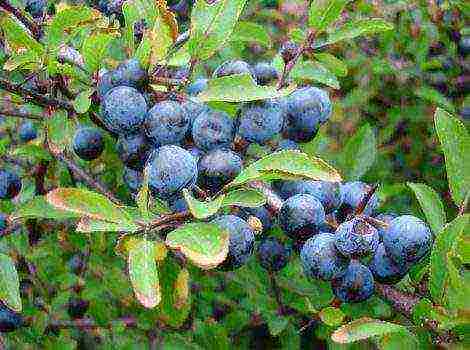Content
Autumn plum care activities important for the fruit tree in order to safely survive the most difficult period - winter. This is a kind of summing up and the beginning of preparation for the new growing season.
In many respects depends on the autumn work, how buds will be laid, fruits will be set and the level of susceptibility of trees to viral and fungal diseases.
The main goal of the gardener in the fall - helping the fruit tree to painlessly survive the phase of relative rest. Despite the fact that in the autumn period the growth of the aboveground part of the plum stops, the active development of the root system continues.
Complex physiological processes take place in the structures of the tree to prepare for the winter period. The main accumulation of active substances occurs in the period after the completion of the growth of shoots before leaf fall.
The lignification of shoots depends on the volume of these reserves, which means resistance to low temperatures. therefore water-charging irrigation is very important, it is necessary to feed the plum in the fall.
To prevent the growth of pest colonies in your country house wood is treated with insecticidal agents... No less important for the health of plums is treatment with fungicides, this will prevent the development of fungal diseases in the spring.
Under the influence of cold, the plum branches' flexibility is lost. This leads to their breakdown under the load of winter precipitation or the effect of squally winds. Preventive pruning will help minimize injury to the fruit tree.
To survive the winter cold and temperature drops will help proper insulation of wood for winter... In addition, the plum needs protection from rodents, which are always activated in winter in search of available food.
How to care for trees and bushes in the fall:
Autumn care activities
Pruning
Plum pruning is done after harvest until mid-September. With such a period, the fruit tree will have time to recover before the first frost, tighten all wounds and cuts.
Pruning steps:
- first of all, attention is paid to overgrown young shoots, they are shortened, leaving 1/3 of the part;
- all dry and painful branches are cut off completely;
- cut off last year's and old branches by 1/3.
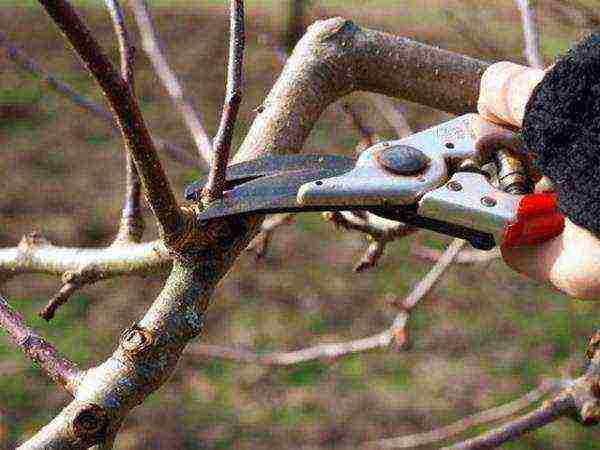
Pruning is carried out with a well-sharpened secateurs. Slices over 1.5 cm in diameter processed with a thin layer of garden varnish.
This event will protect the drain from breaking the trunks under the influence of the load of snow and squally winds.
Proper watering
Autumn watering is important for plums to go through a hardening period. Plum is irrigated in the third decade of September. At the same time, the watering rate is increased three times, for each tree there are from 18 to 24 buckets of water.
You need to keep a close eye on the weather forecast, if heavy rainfall is promised, then you need to refrain from watering.
With high humidity and the establishment of warm weather, growth of shoots and an increase in green mass may occur.therefore in the rainy season, you need to make branch grooves or cover the trunk circle with a thick film.
Good preparation for winter
Microcracks, exfoliated areas of bark and moss - a real haven for spores of fungi and mold. Often hatched pest larvae hide there, and adults lay eggs capable of wintering.
Therefore, before freezing, it is important to carry out preventive cleaning of the trunk. Clean the bark with a wire brushscraping off loose areas, moss and lichens from the trunk and branches.
This event is best combined with pest control., on the trunk of a tree, passages gnawed by them are often found, inside which they can hide. They need to be processed immediately.
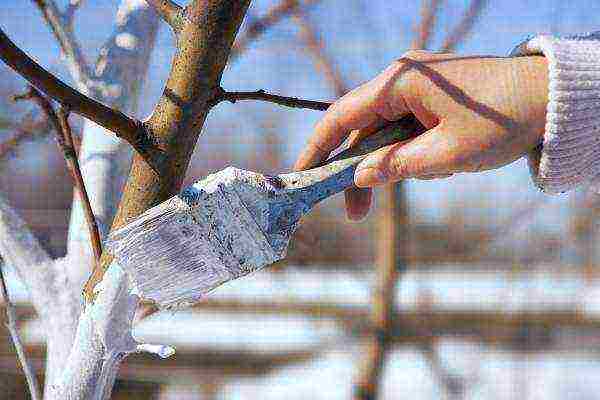
Next, they proceed to whitewash the trunk.... For this, a solution is prepared:
- lime 1 kg;
- clay 1 kg;
- mullein 0.5 kg;
- copper sulfate 300 g
Such a solution will help solve many problems.... The smell of mullein will scare away rodents, clay and lime will reduce the impact of temperature changes. Copper sulfate is a prophylaxis against clotteroporiasis, which develops well in autumn and during winter thaws.
In the middle lane, you can wrap a bole breathable material and additionally cover with spruce branches. The near-trunk circle of plums is mulched with a high layer of peat, sawdust or straw.
Time for feeding and fertilizing
The active growing season severely depletes the internal resources of the tree. therefore in autumn the plum is especially deficient in minerals, which will affect the winter hardiness of the tree. Fertilize and feed the fruit tree immediately after harvesting.
In autumn, plums need all minerals except nitrogen. - a stimulant for the growth of the root system. This mineral is also found in large quantities in organic fertilizers: pig manure and chicken droppings.
When introducing organic matter use rotted cattle manure... It contains a high concentration of potassium, which contributes to the rapid accumulation of carbohydrates.
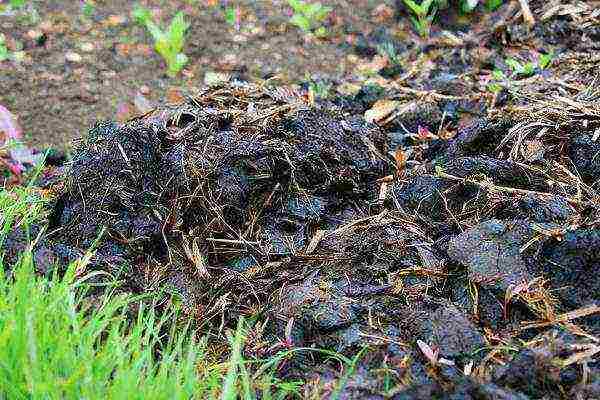
Manure is introduced into the trunk circle at the rate of 5 kg per 1 m2. You can also provide a tree with potassium using a solution of potassium chloride and water (150 g / 10 l).
High-quality and high fruiting plum depends on phosphorus reserves in the internal resources of the tree... There are no natural sources of replenishment of this mineral, and therefore the level of its content in the tree is entirely up to the grower.
For feeding, a solution of superphosphate and water (300 g / 10 l) is introduced into the periosteal circle.
It's also important not to forget about calcium.... This mineral regulates the acidity of the soil and promotes the assimilation of spare nutrients by the tree, which is very important in the formation of young shoots.
To do this, you need to make a solution of sulfate, nitrate, calcium chloride, 25 g each and 10 liters of water. The use of calcium nitrate is not recommended, it contains 15% nitrogen.
Top dressing and pest control:
How to deal with pests in the country
Only those orchards where the number of pests is constantly monitored can be considered a safe and healthy site.
It is important to understand it is impossible to completely isolate the area from insects, and in a minimal amount, they cannot cause significant harm.
Articles that may be of interest to you:
- Effective control of aphids on plums and other fruit trees.
- The most common plum diseases and their treatment.
- Why doesn't the plum blossom and bear fruit, and what to do about it?
Plum is often struck:
- aphid;
- hawthorn;
- goldtail;
- shoot moth;
- plum moth;
- ringed silkworm.
All these pests lay hibernating eggs., and in some species, adults hibernate in cracks in the bark, layers of mulch or soil.
For complete pest control, you need throughout the life of the tree carry out destructive and preventive treatments.
Insecticide spraying in different seasons is done for a specific purpose and complements each other.
Autumn activities for future harvest
The trunk circle is completely dug up, fallen leaves are collected and burned. If you look closely in cracks or in layers of foliage, you will find clutches of eggs. They are destroyed by hand.
If there are not many insects on the drain, processing is carried out with folk remedies:
- infusion of garlic, aged for 1 day (200 g / 10 l);
- a solution of water and onion husks (300 g / 10 l), aged for 5 days;
- ash and soap solution (400 g / 50 g / 10 l).
Additionally you need to spend fumigation with tobacco smoke... To do this, a small pile of straw is placed near the fruit tree, tobacco is scattered over the surface and set on fire. The procedure takes 2 hours.
If the defeat is massive, you cannot do without the use of chemicals. For this, drugs are used: "Karbofos", "Actellik", "Fufanon".

The selected drug must be used in the norms strictly specified in the instructions.
Another important event in the fall - plum treatment with fungicides... Fungal spores begin to actively develop with the first warming and quickly spread throughout the site. An epidemic can be prevented only with the constant suppression of microorganisms and bacteria.
For this, the plum and the periosteal circle sprayed with bordeaux liquid... Consumption for one tree up to 6 years - up to 2 liters, for older trees up to 10 liters.
Spring processing
After the soil warms up to + 15 ° C, new individuals begin to appear from the eggs laid by pests in the fall, which feed on young shoots. This leads to a strong slowdown in the development of plums and the rapid spread of pests throughout the site.
therefore the first treatment must be done before bud break, around mid-March.
Subsequent treatments are carried out if vigorous activity of pests is observed on the drain. Focusing on the volume of reproduction, use folk remedies or chemicals.
Treatment by any means is stopped 30 days before fruiting and the same period of time is not carried out after.
How and when to plant a plum
High-quality grafting means full compatibility of wood species and a procedure performed in accordance with the processes occurring in the tree structure.
Normal fusion of rootstock and scion does not guarantee high-quality development and high productivity of the fruit tree. therefore it is important to accurately determine the compatibility of the grafted crops and possible deviations during development.
Rootstock selection
Rootstock - the basis of a fruit tree... Through its structures, the tree will receive the main nutrients.
The rootstock affects absolutely all vital processes, resistance to frost and drought, the structure of the tree itself and the quality of the fruit. Therefore, his choice is treated with special attention.
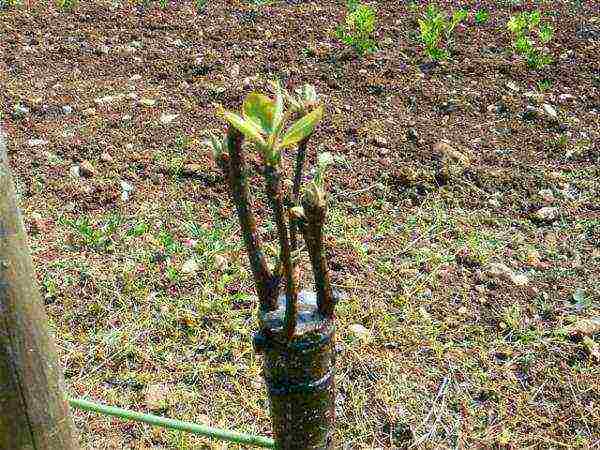
Plum rootstocks:
- Cherry plum... One of the main rootstocks for the southern regions. Differs in quick adaptation to all types of soil and good development of the fruit tree.
- Ternoslum... A good stock for use in central Russia. The main advantages are winter hardiness and drought resistance.
- Thorn... Hardy and frost-resistant stock. It is used as an additional stock in the middle zone of horticulture and in the northern regions.
- Ussuriyskaya plum... Differs in high frost resistance. Most often used in the Urals, Siberia and the Far East. Under conditions of a temperate climate, it is possible to undermine the crust, therefore, it is practically not used in the middle lane.
- Canadian plum... From this rootstock, winter-hardy, fruitful and early-growing trees grow. It is massively used in the Altai Territory, the Urals and Siberia.
- Seedlings of cultivars... Seedling rootstocks are mainly used in the middle gardening zone. For this, zoned varieties are selected.
Harvesting cuttings
Cuttings for grafting are harvested only after the complete cessation of sap flow. This occurs when the trees shed their leaves and enter a dormant period.
This is due to the movement of plastic substances from annual increments downward under the influence of daytime temperature warming up. Such cuttings cannot build up the callus necessary for fusion with the stock.
For the scion, strong annual shoots are cut not less than 5 mm in diameter and 40 cm in length with healthy apical growth and lateral leaf buds.
It is not difficult to define them - this is the final branch before the first branch. Shoots growing from tops, directed steeply upward, are not suitable for grafting.
Store cuttings in a moist substrate from sawdust or sand at a temperature of + 1 ° C - + 5 ° C. The substrate must be periodically moistened.
Vaccination methods
There are many ways to vaccinate fruit tree. Each of them has its own characteristics and is used depending on the characteristics of the inoculated material and the season of the procedure.
If there is no vaccination experience, it is better to start with the simplest and most understandable wayswhich almost always give good results.
Plum grafting, master class:
Copulation
This is a very easy way to vaccinate. and is used with the same diameter (no more than 1.5 cm) of the rootstock and scion. On the handle and on the rootstock, the same oblique and smooth cuts are made, 3-4 cm long.
The graft and rootstock are connected to each other so that the cambial layers coincide. The junction of the cuts is tightly tied with a film. The upper cut of the cutting is treated with garden pitch.

For the bark
This vaccination method is used when new varieties need to be grafted onto an adult or old plum... The procedure is carried out after the start of sap flow. At this time, the bark becomes plastic and easily lags behind the wood.
Procedure steps:
- the stock is cut with a saw into a stump and treated with garden pitch;
- the bark is incised downward to a length of 2.5 cm;
- the cut bark is slightly turned off on both sides;
- at the lower end of the cutting, an oblique cut is made by 3 cm at an angle of 30 °;
- 2-3 buds are left on the handle, the rest is cut off (above the kidney);
- the handle is inserted behind the bark;
- the vaccination site is fixed with a film and coated with garden varnish.
A fruit garden will develop harmoniously only with a full understanding of the characteristics of all plants and compliance with the rules for caring for them.
It is important not to disturb the natural processes of the fruit tree - this often leads to global problems. This is the only way to achieve longevity and stable fruiting of plums.

